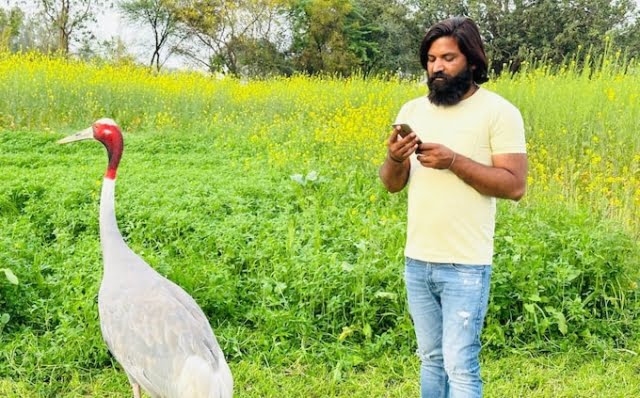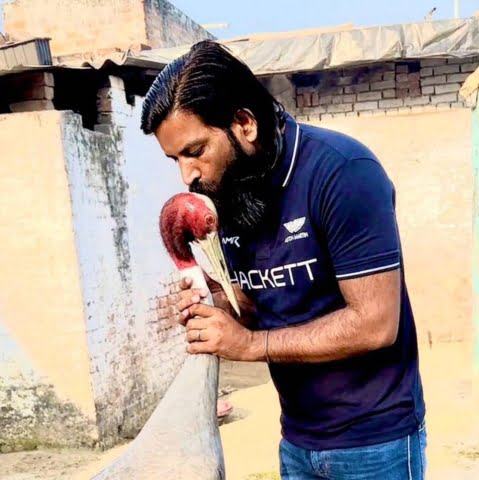 Muhammad Arif cured a crane after it broke its leg
Muhammad Arif cured a crane after it broke its leg
An Indian whose love affair with a rare crane made international headlines, urged the government to reunite him with the bird after it was confiscated by wildlife authorities.
Muhammad Arif, a farmer in northern India's Uttar Pradesh state, discovered the crane in a field last March. . His leg was broken.
Within a few weeks, Mr. Arif, 35, cured the creature with traditional medicine.
Mr. Arif claims that he and the animal that he calls simply «friend», are in love and say that he moved away from his family and friends to live with Sarus the crane.
They shared traditional Indian dishes such as dal, rice and roti from the same plate, and the bird guarded Mr. Arif's door while he slept.
The crane returned to the forest from time to time, but returned. Arifu for several hours.
Videos of the bird flying alongside Mr. Arif as he rides his motorcycle went viral on social media and he has amassed almost 300,000 followers on Instagram. documenting their exploits.
Healthy Biker and his Crane [1] Replica of the Healthy Biker and his Crane [2]
But Mr. Arif's happiness was short-lived. Last month, Indian forestry workers visited his home in Mandha village and took the crane to a zoo more than 250 miles away, accusing Mr. Arif of keeping the endangered bird under the Indian Wildlife Conservation Act.
“ I am in deep pain after they separated my friend from me. It's like a member of my family is in a cage. It worries me,” Mr Arif told The Telegraph. «The government should relieve us of this pain.»
The farmer has stayed near the zoo since the animal was brought there.
“Without the zoo, my house is like a cage for me. I wander from one place to another so as not to return home,” he said.
Mr. Arif said he was pleased with his newfound fame, but accused forestry officials of depriving him of his happiness.
«It was the first time I felt so much sympathy for anyone,» he said, referring to the crane.
Copy Copy of the Big Biker and his crane [3]
Mr. Arif was recently allowed to briefly see a crane at the Allen Forest Zoo in Kanpur, where he is kept.
He said the bird recognized him when he reached the cage where it was undergoing a 15-year inspection. quarantine day, flapping and dancing as he approached.
“I saw him tormented trying to escape this place,” he said. “I started crying when I saw this. I was emotionally overwhelmed when he flapped his wings and tried to break the wall. I felt that he wanted to come with me.”
Video of the meeting shows the bird walking around the enclosure, raising and lowering its head and showing its plumage in the direction of Mr. Arif.
After a three-minute visit, Mr. Arif was asked to leave. He urged the zoo authorities to release the bird back into the wild after the end of the quarantine period.
Mr Arif believes the bird will make the 150-mile journey home to his village if released. .
 A couple in happier times
A couple in happier times
Tarun Kumar Roy, an expert on Asian waterfowl at Wetland International, said the bird was most likely a male.
Typically, sarah cranes mate for life, he said, adding that the bird may have formed a bond with Mr. Arif because its former partner had died.
“The bird often flew into the forest, and if its mate [still] were alive , she would not return to the House of Arif,” he told The Telegraph.
“So he considers Mr. Arif his mate,” said Mr. Roy.
“Arif saved him from possible death. He gave the bird good food and freedom of movement, which gave the bird a sense of friendship and protection,” he added.
Mr. Roy also urged the zoo to let the bird go.
< p>“They can’t keep the bird in a closed shelter. He does not eat properly, and if he is not released, he will die because he feels alone. You could see how he goes crazy when he sees Arif,” he said.
 Farmer Mohammad Arif with his beloved crane
Farmer Mohammad Arif with his beloved crane
The confiscation of the bird caused a strong reaction in India and around the world.
A petition to free the bird was launched earlier this month and has garnered almost 10,000 signatures. .
With a wingspan of nearly eight feet and a height of over five feet, the sarus crane is the tallest flying bird in the world. It is non-migratory and is found in parts of the Indian subcontinent, Southeast Asia and Australia.
There are currently about 20,000 birds in India and they are listed as a vulnerable species.< /p>
White birds with bright red feathers on their heads and black wingtips are often found in rice fields, along rivers and irrigation canals near Mr. Arif's village.
He plans to start a non-profit organization to treat injured birds before releasing them into the wild.
























































Свежие комментарии